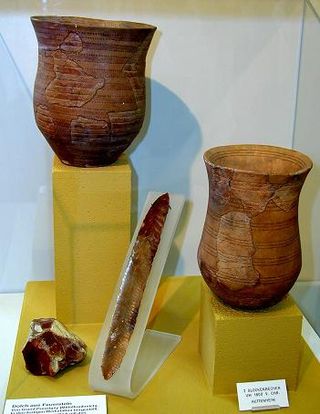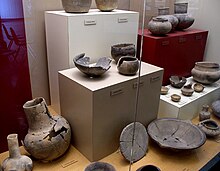Post-processual archaeology, which is sometimes alternatively referred to as the interpretative archaeologies by its adherents, is a movement in archaeological theory that emphasizes the subjectivity of archaeological interpretations. Despite having a vague series of similarities, post-processualism consists of "very diverse strands of thought coalesced into a loose cluster of traditions". Within the post-processualist movement, a wide variety of theoretical viewpoints have been embraced, including structuralism and Neo-Marxism, as have a variety of different archaeological techniques, such as phenomenology.
Systems theory in archaeology is the application of systems theory and systems thinking in archaeology. It originated with the work of Ludwig von Bertalanffy in the 1950s, and is introduced in archaeology in the 1960s with the work of Sally R. Binford & Lewis Binford's "New Perspectives in Archaeology" and Kent V. Flannery's "Archaeological Systems Theory and Early Mesoamerica".
Lewis Roberts Binford was an American archaeologist known for his influential work in archaeological theory, ethnoarchaeology and the Paleolithic period. He is widely considered among the most influential archaeologists of the later 20th century, and is credited with fundamentally changing the field with the introduction of processual archaeology in the 1960s. Binford's influence was controversial, however, and most theoretical work in archaeology in the late 1980s and 1990s was explicitly construed as either a reaction to or in support of the processual paradigm. Recent appraisals have judged that his approach owed more to prior work in the 1940s and 50s than suggested by Binford's strong criticism of his predecessors.

Culture-historical archaeology is an archaeological theory that emphasises defining historical societies into distinct ethnic and cultural groupings according to their material culture.

Material culture is the aspect of culture manifested by the physical objects and architecture of a society. The term is primarily used in archaeology and anthropology, but is also of interest to sociology, geography and history. The field considers artifacts in relation to their specific cultural and historic contexts, communities and belief systems. It includes the usage, consumption, creation and trade of objects as well as the behaviors, norms and rituals that the objects create or take part in.
Cognitive archaeology is a theoretical perspective in archaeology that focuses on the ancient mind. It is divided into two main groups: evolutionary cognitive archaeology (ECA), which seeks to understand human cognitive evolution from the material record, and ideational cognitive archaeology (ICA), which focuses on the symbolic structures discernable in or inferable from past material culture.
Archaeological theory refers to the various intellectual frameworks through which archaeologists interpret archaeological data. Archaeological theory functions as the application of philosophy of science to archaeology, and is occasionally referred to as philosophy of archaeology. There is no one singular theory of archaeology, but many, with different archaeologists believing that information should be interpreted in different ways. Throughout the history of the discipline, various trends of support for certain archaeological theories have emerged, peaked, and in some cases died out. Different archaeological theories differ on what the goals of the discipline are and how they can be achieved.
Michael Brian Schiffer is an American archaeologist and one of the founders and pre-eminent exponents of behavioral archaeology.
Gordon Randolph Willey was an American archaeologist who was described by colleagues as the "dean" of New World archaeology. Willey performed fieldwork at excavations in South America, Central America and the Southeastern United States; and pioneered the development and methodology for settlement patterns theories. He worked as an anthropologist for the Smithsonian Institution and as a professor at Harvard University.
Conjunctive archaeology is a method of studying of the past developed by Walter Taylor in the 1940s that combined elements of both traditional archaeology and the allied field of anthropology. It is exemplified by Taylor's A Study of Archeology (1948).
The archaeological record is the body of physical evidence about the past. It is one of the core concepts in archaeology, the academic discipline concerned with documenting and interpreting the archaeological record. Archaeological theory is used to interpret the archaeological record for a better understanding of human cultures. The archaeological record can consist of the earliest ancient findings as well as contemporary artifacts. Human activity has had a large impact on the archaeological record. Destructive human processes, such as agriculture and land development, may damage or destroy potential archaeological sites. Other threats to the archaeological record include natural phenomena and scavenging. Archaeology can be a destructive science for the finite resources of the archaeological record are lost to excavation. Therefore, archaeologists limit the amount of excavation that they do at each site and keep meticulous records of what is found. The archaeological record is the physical record of human prehistory and history, of why ancient civilizations prospered or failed and why those cultures changed and grew. It is the story of the human world.
Timothy R. Pauketat is an American archaeologist, director of the Illinois State Archaeological Survey, the Illinois State Archaeologist, and professor of anthropology and medieval studies at the University of Illinois at Champaign-Urbana. He is known for his historical theories and his investigations at Cahokia, the major center of precolonial Mississippian culture in the American Bottom region of Illinois near St. Louis, Missouri.

Archaeology or archeology is the study of human activity through the recovery and analysis of material culture. The archaeological record consists of artifacts, architecture, biofacts or ecofacts, sites, and cultural landscapes. Archaeology can be considered both a social science and a branch of the humanities. It is usually considered an independent academic discipline, but may also be classified as part of anthropology, history or geography.
Marxist archaeology is an archaeological theory that interprets archaeological information within the framework of Marxism. Although neither Karl Marx nor Friedrich Engels described how archaeology could be understood in a Marxist conception of history, the archaeological theory was developed by Soviet archaeologists in the Soviet Union during the early twentieth century. Marxist archaeology quickly became the dominant archaeological theory within the Soviet Union, and subsequently spread and was adopted by archaeologists in other countries. In particular, in the United Kingdom, where the theory was propagated by an influential archaeologist V. Gordon Childe. With the rise of post-processual archaeology in the 1980s and 1990s, forms of Marxist archaeology were once more popularised amongst the archaeological community.
Stanley A. South was an American archaeologist who was a major proponent of the processual archaeology movement. South's major contributions to archaeology deal in helping to legitimize it as a more scientific endeavor. Additionally, South participated in the excavation and research of a number of historic sites throughout North and South Carolina, including Town Creek Indian Mound, Charles Towne Landing (SC), Brunswick Town, North Carolina, Bethabara Historic District, the John Bartlam site at Cain Hoy (SC), and Santa Elena, as well as Fort Dobbs and the Fayetteville Arsenal.

American anthropology has culture as its central and unifying concept. This most commonly refers to the universal human capacity to classify and encode human experiences symbolically, and to communicate symbolically encoded experiences socially. American anthropology is organized into four fields, each of which plays an important role in research on culture:
- biological anthropology
- linguistic anthropology
- cultural anthropology
- archaeology
Albert Clanton Spaulding was an American anthropologist and processual archaeologist who encouraged the application of quantitative statistics in archaeological research and the legitimacy of anthropology as a science. His push for thorough statistical analysis in the field triggered a series of academic debates with archaeologist James Ford in which the nature of archaeological typologies was meticulously investigated—a dynamic discourse now known as the Ford-Spaulding Debate. He was also instrumental in increasing funding for archaeology through the National Science Foundation.
Sally Binford was an archaeologist and feminist. A prehistorian, she contributed alongside her husband to the formation of processual archaeology.
There are two main approaches currently used to analyze archaeological remains from an evolutionary perspective: evolutionary archaeology and behavioral ecology. The former assumes that cultural change observed in the archaeological record can be best explained by the direct action of natural selection and other Darwinian processes on heritable variation in artifacts and behavior. The latter assumes that cultural and behavioral change results from phenotypic adaptations to varying social and ecological environments.
Behavioural archaeology is an archaeological theory that expands upon the nature and aims of archaeology in regards to human behaviour and material culture. The theory was first published in 1975 by American archaeologist Michael B. Schiffer and his colleagues J. Jefferson Reid, and William L. Rathje. The theory proposes four strategies that answer questions about past, and present cultural behaviour. It is also a means for archaeologists to observe human behaviour and the archaeological consequences that follow.




